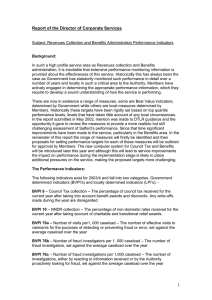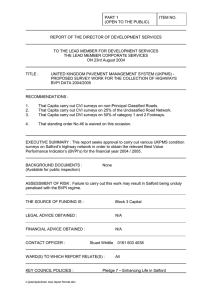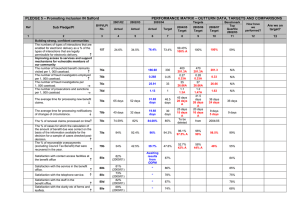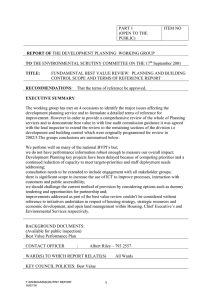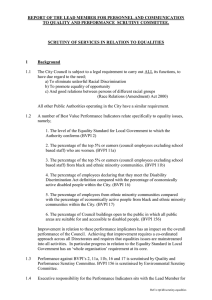Report of the Director of Corporate Services
advertisement
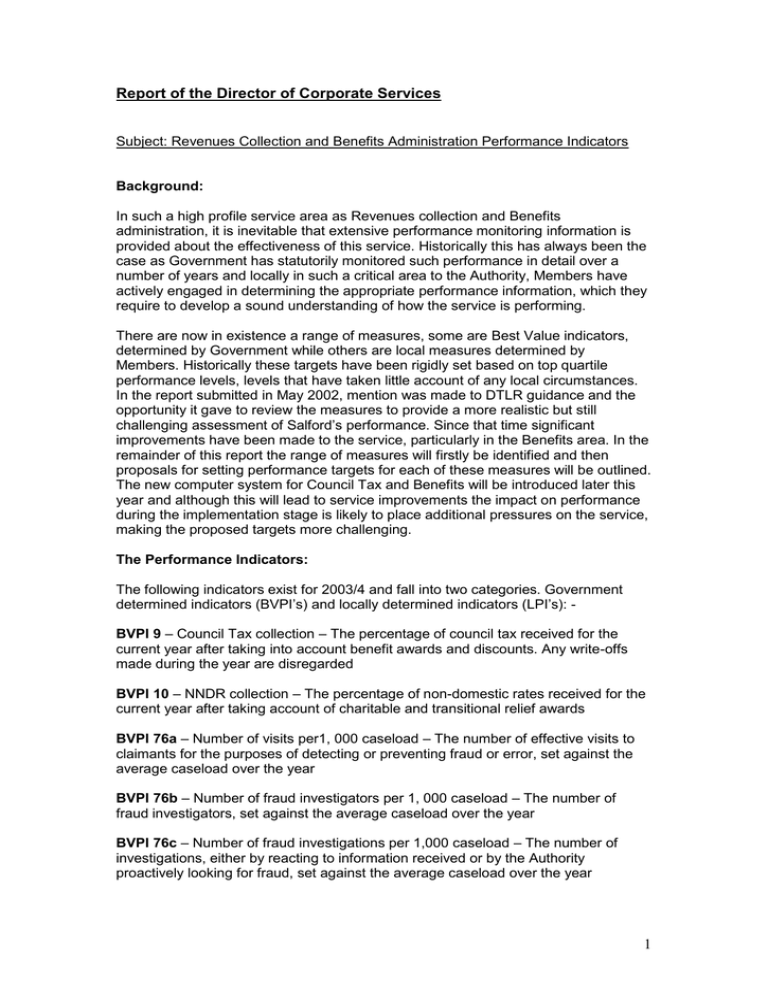
Report of the Director of Corporate Services Subject: Revenues Collection and Benefits Administration Performance Indicators Background: In such a high profile service area as Revenues collection and Benefits administration, it is inevitable that extensive performance monitoring information is provided about the effectiveness of this service. Historically this has always been the case as Government has statutorily monitored such performance in detail over a number of years and locally in such a critical area to the Authority, Members have actively engaged in determining the appropriate performance information, which they require to develop a sound understanding of how the service is performing. There are now in existence a range of measures, some are Best Value indicators, determined by Government while others are local measures determined by Members. Historically these targets have been rigidly set based on top quartile performance levels, levels that have taken little account of any local circumstances. In the report submitted in May 2002, mention was made to DTLR guidance and the opportunity it gave to review the measures to provide a more realistic but still challenging assessment of Salford’s performance. Since that time significant improvements have been made to the service, particularly in the Benefits area. In the remainder of this report the range of measures will firstly be identified and then proposals for setting performance targets for each of these measures will be outlined. The new computer system for Council Tax and Benefits will be introduced later this year and although this will lead to service improvements the impact on performance during the implementation stage is likely to place additional pressures on the service, making the proposed targets more challenging. The Performance Indicators: The following indicators exist for 2003/4 and fall into two categories. Government determined indicators (BVPI’s) and locally determined indicators (LPI’s): BVPI 9 – Council Tax collection – The percentage of council tax received for the current year after taking into account benefit awards and discounts. Any write-offs made during the year are disregarded BVPI 10 – NNDR collection – The percentage of non-domestic rates received for the current year after taking account of charitable and transitional relief awards BVPI 76a – Number of visits per1, 000 caseload – The number of effective visits to claimants for the purposes of detecting or preventing fraud or error, set against the average caseload over the year BVPI 76b – Number of fraud investigators per 1, 000 caseload – The number of fraud investigators, set against the average caseload over the year BVPI 76c – Number of fraud investigations per 1,000 caseload – The number of investigations, either by reacting to information received or by the Authority proactively looking for fraud, set against the average caseload over the year 1 BVPI 76d – Number of prosecutions & sanctions per1, 000 caseload – The number of cases where a punishment has been appropriate, set against the average caseload over the year BVPI 78a – HB/CTB New Claims – The average processing time taken across all new claims for which the date of decision is within the period being reported on. The time for each claim is measured from the date of receipt of the claim to the date of decision BVPI 78b – HB/CTB Changes of Circumstances – The average processing time taken across all written notifications of changes, which require a new decision for which the date of the new decision is within the period being reported on. BVPI 78c – HB/CTB Renewals – The number of renewal claims decided before the end of the existing benefit period as a percentage across all renewal claims for which the date of decision is within the period being reported on BVPI 79a – HB/CTB Accuracy – The percentage of cases within a random sample for which the calculation of benefit is found to be correct BVPI 79b – Overpayment Recovery – The value of cash recovered during the period being reported on as a percentage of the value of recoverable overpayments identified by the Authority on or after 1st April 2003 plus any recoverable overpayments identified in the period 1st April 2000 – 31st March 2003 which remain un-recovered on 31st March 2003 LPI 27 – Council Tax arrears collection – The percentage reduction in the level of arrears since the start of the financial year, taking into account benefit and discount awards, payments and write-offs. LPI 29 – Cost of collection Council Tax – The average cost of collecting tax from each dwelling in the valuation list where there is an associated charge raised by the Authority in respect of those dwellings LPI 30 – Cost of HB/CTB claims – The average cost of administering a HB/CTB claim set against the average caseload over the year Proposed three-year Targets for 2004/06: BVPI 9 – Council Tax collection: The collection rate for 2003/4 was 91.4%, which was 0.2% ahead of target for the year and a significant achievement for the Recovery Section. This indicator focuses solely on current year collections and not on arrears from earlier years. Members will recall that in the last 12 months we have entered into a new contract with external bailiff companies and during this period a significant amount of work has been undertaken to forward arrears cases to the bailiffs. In addition, write offs have been made to significant amounts of arrears and this will allow greater focus on more recent debts in the coming months. Together with a more stringent recovery plan for the coming year, it is reasonable to set future targets which show continuous improvements over the next three years. For this reason, it is proposed increase the target for 2004/5 to 92% with 1% increases for 2005/6 and 2006/7. This will represent a significant challenge for a service expecting to introduce a new computer system within the next 12 months. 2 BVPI 10 – NNDR collection: The collection rate for 2003/4 was 97.0%, which was 0.6% ahead of target and a significant achievement for the team. We therefore propose to set a challenging target of 98% for 2004/5 followed by 0.5% improvements for the following two years. This will mean that business rate collections will achieve top quartile performance by 2006/7. BVPI 76a – Number of visits per 1,000 caseload: The PI’s 76a to 76d were new in 2003/4 so it was difficult to set future targets as there was little or no data on which to base expected performance. There have also been significant amendments to the benefit regulations, which resulted in changes in working practices. For the PI concerned with the number of visits we undertake, the target for 2003/4 was 9,900 based on an overall caseload of 30,000. However, regulation changes removing the requirement for pensioners to renewal their claims, implemented with effect from July 2003, meant that a more realistic number of visits for the current year would be 5,000. Furthermore, the targets for future years are to be determined by DWP and in a recent circular it was indicated that for 2004/5 the target will be 6,040 visits. For the purposes of this report it is therefore proposed to set the targets for the following three years at the level currently indicated by DWP. BVPI 76b – Number of fraud investigators per 1,000 caseload: Based on the level of the current caseload this indicator was 0.28 per 1,000 cases in 2003/4. However, during the last year additional staffing resources have been undertaking PINS training and these should start to have a greater impact on the work of the section in the coming year. Taking into account the other activities these officers undertake on behalf of the team it is expected that the indicator will increase to 0.333 per 1,000 cases in 2004/5 and it is therefore proposed to set this target for the next three year’s. In terms of staff numbers this equates to 10 full time posts. BVPI 76c – Number of fraud investigations per 1,000 caseload: The length of individual investigations varies significantly but over a period of time and it has been identified during the course of the year that some investigations should be more fully investigated. In the coming year we propose to provide more support for investigating officers in the form of case auditing which is expected to result in more enquiries in some cases and an increase in the number of prosecutions and sanctions. For this reason it has been estimated that a challenging target for the team to undertake would be 800 per year, which equates to 26.66 per 1,000 caseload and it is proposed to set the target for the coming three years at this level. BVPI 76d – Number of prosecutions & sanctions per 1,000 caseload: Taking into account the experiences of 2003/4 and the proposals to improve the investigation process with case auditing, it is proposed to set targets for the next three years which will show an increase of 5 cases per year, over the period. BVPI 78a – HB/CTB New Claims: Current performance on processing new benefit claims has been around the 30-day mark throughout the year, which is well within our target of 48.5 days and the top quartile standard of 36 days. In order to improve on this standard we need to work on reducing the number of new claims that have to be returned to customers because 3 the claim form hasn’t been completed properly. This is also an important issue for landlords as it can help to reduce arrears levels building at the beginning of tenancies and it is proposed to work with landlords (including NPHL) to encourage them to assist tenants with this. It is proposed to set more challenging targets for 2004/5 onwards by setting a target of 28 days, followed by an improvement of 2 days per year over the next two years. BVPI 78b – HB/CTB Changes of Circumstances: We currently process changes in around 19 days and although this is well within our current target of 30 days it is short of the top quartile of 9 days. A review of how this work is done has been undertaken recently and some improvements have been made to our working arrangements that have helped. One recent change was to initiate weekly processing of changes within our computer system. Previously some of these had been done on a four weekly cycle. Further improvements are planned for the daily processing of claims, which should also help. An overriding factor in processing change of circumstances is similar to that of new claims in that the initial notification of a change doesn’t always include sufficient information to enable the change to be made to the claim. This results in a letter being sent asking for further information. It is easy to see that such a process will take a number of days to resolve the situation and as the PI is calculated from the day the first notification was received, the effect these cases have is significant. Also, it is thought that the recent regulation changes on Pension Credits may also have a significant impact on workload levels in this area and that this may result in a decline in performance standards nationally. The proposals set challenging targets, which will lead to achieving top quartile within three years (15 days for 2004/5, 10 days for 2005/6 and 5 days for 2006/7). However, if national performance standards suffer as a result of these regulation changes, we may achieve top quartile earlier. BVPI 78c – HB/CTB Renewals: The changes to the benefit regulations, which took effect in April 2004, remove the requirement for claimants to renew their claims on an annual basis. This particular PI will therefore be removed from the list of Best Value PI’s at that time. BVPI 79a – HB/CTB Accuracy: This is a measure of how accurately we process claims and as such our targets should present a challenge of the highest standard. This indicator is measured on a very small sample of cases, selected randomly from the whole caseload. The results of this sampling process can therefore be somewhat erratic but despite this it is proposed to set targets over the next three years of 97.5% for 2004/5, 98.0% for 2005/6 and 98.5% 2006/7. BVPI 79b – Overpayment Recovery: Collection of benefit overpayments stood at 39.7% at the end of the financial year. Benefit overpayments are particularly difficult to recover as they usually affect the poorer sections of society and a significant portion of the debt is recovered from ongoing deductions from weekly benefit awards, which results in collection being relatively slow. We have fallen well short of the 2003/4 target of 47.6% and for this reason we propose to adjust the targets for the coming three years while still providing a significant challenge for the team. The proposed targets are 42% for 2004/5, 44% for 2005/6 & 46% for 2006/7. 4 LPI 27 – Council Tax arrears collection: During the course of the current financial year significant efforts have been made to clear the accounts of irrecoverable debts and Members have made good use of the provisions for writing off such debts so that we can focus resources on those debts that can be recovered. Our current performance as at the end of the financial year is 47.34%, which is well above target. This is due at least in part to the significant amounts written off during the year. In addition, being a locally set PI there is little accurate data available from other authorities for us to compare our performance to. For these reasons it is proposed to set a target for the next three years of 30%. LPI 29 – Cost of collection Council Tax: The cost of collection is currently £13.67, compared with the target for 2003/4 of £9.59. Being a local PI there are no reliable national statistics to compare to and the reliability of statistics from other local authorities in the area is also in some doubt. For this reason it is proposed to change the basis of this PI to one linked to the cost of the service, plus the level of the annual pay award for staff. The current level of costs for the collection of Council Tax is £1.32m, therefore the proposed targets for the next three years would be this figure plus an amount calculated by applying the percentage of the pay award to this figure. LPI 30 – Cost of HB/CTB claims: The current cost of a claim is £107.97, which exceeds the locally set target of £73.03 by some margin. As with LPI29 we have no reliable statistics to compare our performance to and for this reason it is proposed to set targets in a similar way to that used for LPI 29, based on current cost levels of £4.46m 5 Performance Indicator Targets – Revenues and Benefits Indicator Description Top quartile performance BVPI 9 BVPI 10 BVPI 76a Council Tax Collection NNDR Collection Number of visits per 1000 caseload 98.0% 99.0% - BVPI 76b Number of Fraud Investigators per 1000 caseload No of Fraud Investigations per 1000 caseload Prosecutions and Sanctions per 1000 caseload HB/CTB New Claims HB/CTB Change of Circumstances HB/CTB Renewal HB/CTB Accuracy HB Overpayment Recovery Council Tax Arrears Collection Cost of collecting Council Tax Cost of HB/CTB claim - BVPI 76c BVPI 76d BVPI 78a BVPI 78b BVPI 78c BVPI 79a BVPI 79b LPI 27 LPI 29 LPI 30 Current Target Current Performance Proposed Targets 2004/5 2005/6 2006/7 92.0% 98.0% 6,040 201.3 visits per 1000 0.33 per 1,000 = 10 fte 800 26.66 per 1000 39 1.30 per 1,000 28 days 15 days 93.0% 98.5% 6,040 201.3 visits per 1000 0.33 per 1,000 = 10 fte 800 26.66 per 1000 44 1.47 per 1,000 26 days 10 days 94.0% 99.0% 6,040 201.3 visits per 1000 0.33 per 1,000 = 10 fte 800 26.66 per 1000 49 1.63 per 1,000 24 days 5 days Deleted 2004 98% 44% 98.5.% 46% 36 days 9 days 91.2% 96.4% 9,900 pa 330 visit per 1000 0.25 per 1,000 = 7.5 fte 990 33 per 1000 30 1 per 1,000 48.5 days 30 days 91.4% 97.0% 5,005 pa 166.88 visits per 1000 0.268 per 1,000 = 10 fte 777 25.91 per 1000 34 1.13 per 1,000 31.2 days 19.68 days 83% N/A N/A 85% 94.3% 47.6% 84.08% 96.2% 39.69% N/A 33.85% 47.34% 30% 30% 30% N/A £9.59 £13.67 £1.32m + PA 2004/5 + PA 2005/6 + PA N/A £73.03 £107.97 £4.46m + PA 2004/5 + PA 2005/6 + PA - - To be 97.5% 42% 6
